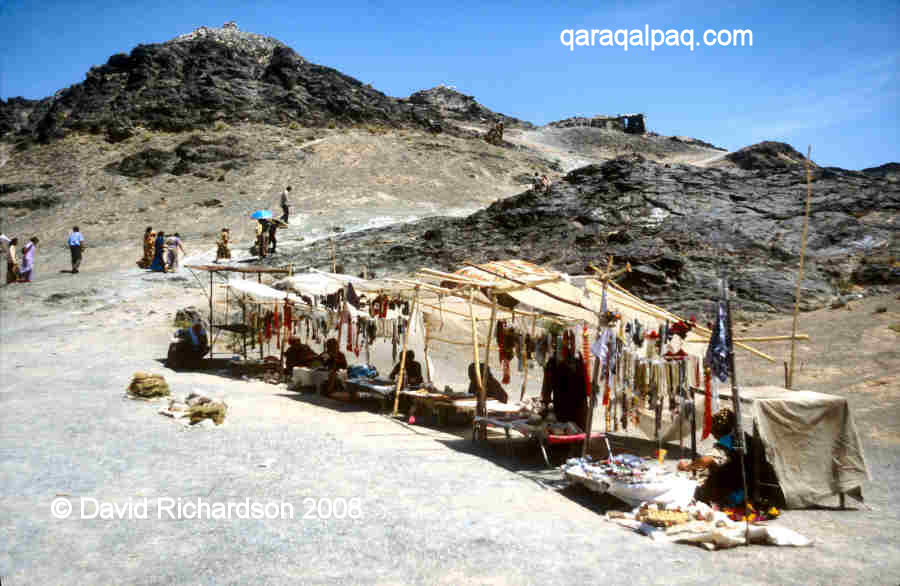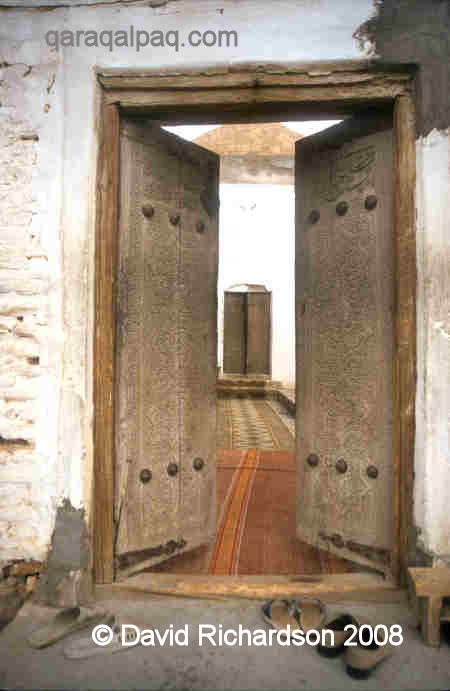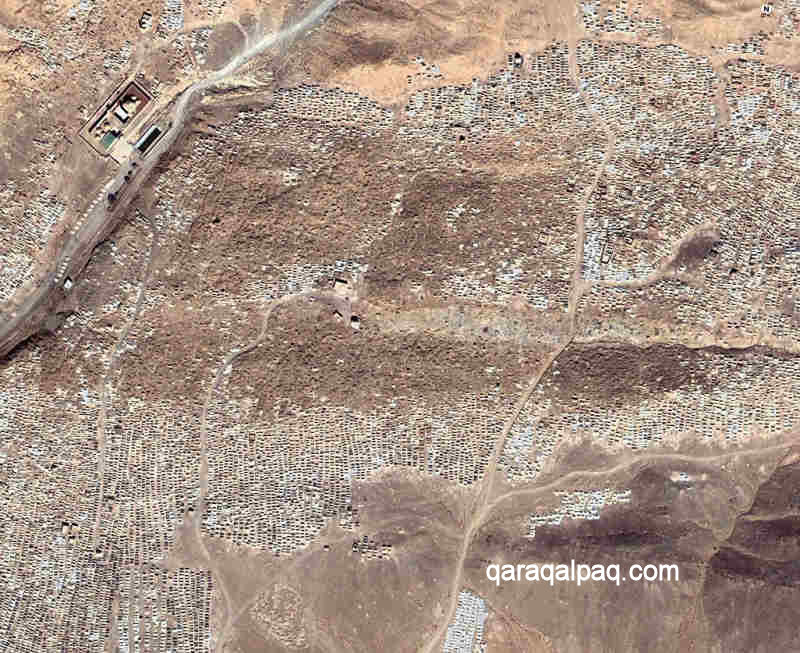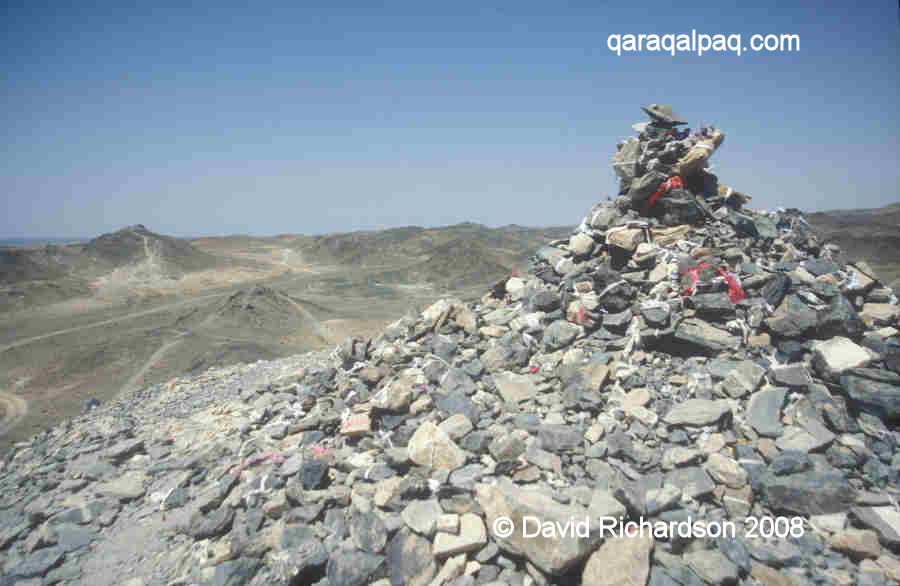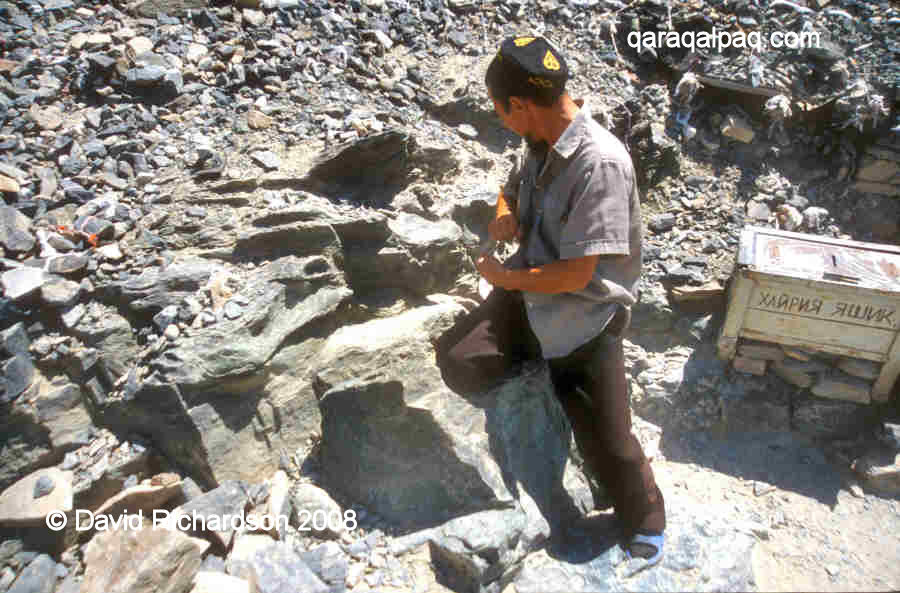|
Location
The Sultan Uvays Bobo mausoleum is located in the barren southern foothills of the mountain chain that bears the name of the Sufi saint - the Sultan
Uvays Dag. The mausoleum is surrounded by a massive mazar or cemetery. Higher up the mountain is a holy place said to bear the marks of the
Sultan's footprint and knee.
Satellite image of the mausoleum (top left of centre) and the surrounding mazar.
The site is entered from the south. Image courtesy of Google Earth.
To reach the mausoleum leave Biruniy on the main A380 heading for No'kis. The road gradually turns to the right until it heads almost due north in a
straight line for the mountains. Some 34km from the centre of Biruniy the road starts turning to the left. After ½km turn right onto a well-worn
side road and after a further ½km turn left. The road now winds up a valley into the mountains and after a further 2.8km arrives at some
buildings and stalls selling amulets and snacks. Continue for a further 0.8km to reach the mausoleum.
Pilgrims walking up to the holy mountain site of Sultan Bobo. Note the amulet sellers in the foreground.
After visiting the mausoleum you can continue driving up into the mountains for a further 3.25km to reach a car park from where you make a short climb
up to a holy site, said to contain the foot and knee prints of the Sultan.
After returning back to the A380 it is about another 110km to No'kis.
The Mausoleum
This simple mausoleum is said to contain the tomb of a Sufi saint known locally as Sultan Bobo or Sultan Uvays. However throughout the wider Islamic
world he is known as Sultan Uways al-Qarani, at least according to the standard Arabic transliteration.
Entrance to the Sultan Uvays Bobo mausoleum.
His full name was Sayyidinaa Uways bin 'Amir al-Qarani and he was a simple camel shepherd who came from the village of Qaran in the Yemen. He was a
contemporary of the Prophet Mohammed and is regarded in some Islamic quarters as the founder of the Islamic Sufi movement.
Early Islamic writings claim that while living in the Yemen, Uways al-Qarani inwardly received the teachings of the Prophet and became a devout Muslim.
He was inspired to travel to Medina to meet the Prophet Mohammed but his mother, who was blind, only gave him permission to go provided that he return
immediately once he had reached the Prophet's house. After a three month journey he arrived in Medina only to find that the Prophet was not at home.
True to his promise he returned to the Yemen without ever fulfilling his objective.
Despite having never met Uways in the flesh, the Prophet would frequently refer to him, sometimes saying "I feel the breath of the Merciful, coming to
me from Yemen". Shortly before his death in 632, the Prophet ordered two of his closest companions: Omar (who would later become the second caliph) and Ali
(the husband of the Prophet's daughter Fatima) to take his cloak and give it to Uways in the Yemen.
Because of Uways al-Qarani's spiritual initiation into the Islamic faith without the involvement of any physical teaching he was pronounced a saint and
has been venerated by the faithful ever since. The so-called "Uwaysi connection" has become a model for understanding and explaining visionary
experiences in which a student becomes initiated, perhaps by a deceased imam or sheikh. The Uwaysi school of Sufism even continues
today under the banner of the Maktab Tarighat Oveyssi Shahmaghsoudi, or the "School of the Path of Uways".
It is highly unlikely that Uways al-Qarani is buried in the mountains that bear his name. Tombs associated with Uways al-Qarani can be found at two
sites in Syria – namely Damascus and Raqqa – and at another close to Zabid in the Yemen. Uways apparently died in 656/657.
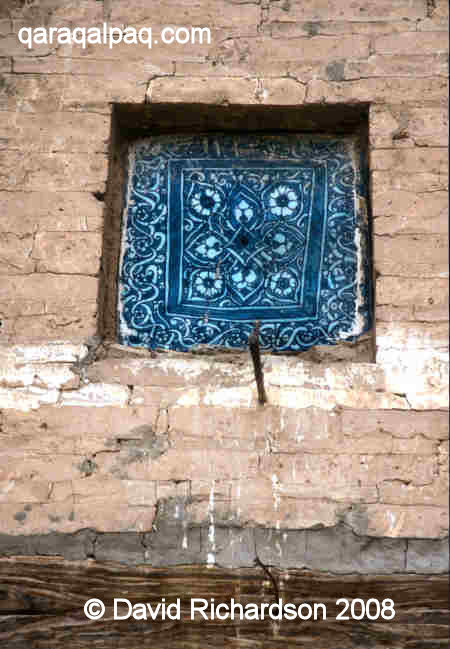
|
A blue-glazed Khorezmian tile above a doorway in the mausoleum.
The origins of the present mausoleum probably date back to the time of the arrival of the Sufi movement in Central Asia, around the 9th century AD.
Ceramic finds suggest that the site was completely occupied by the 10th century at the latest. However the present structure seems to have been
mainly constructed between the 17th and 19th centuries. In the 1920s and 1930s it was regarded as one of the holiest places in Central Asia and was
a popular pilgrimage destination. However as Stalin's Soviet authorities increasingly attempted to clamp down on religious institutions, the mausoleum
was officially closed in the 1960s. Following perestroika and the collapse of the USSR its popularity has been restored.
There is a large rectangular fish tank at the steps leading up to the mausoleum, which is entered through old beautifully carved wooden doors. The
main mausoleum is built from yellow fired bricks and its walls have been whitewashed. The mausoleum and some of the adjacent buildings have domes
covered with square unglazed clay tiles. The buildings are arranged around a small internal courtyard.
The Mazar
The mausoleum is surrounded by a huge cemetery with tombs aligned in rows across the surrounding hills. The Qaraqalpaqs normally refer to simple
cemeteries as a'wılie but because of the presence of a holy mausoleum this one is called a mazar.
The huge mazar surrounding the mausoleum. Image courtesy of Google Earth.
The Sultan's Footprint
The mountain top at the head of the valley contains a number of small inundations, purported to be the footprints and knee prints of Sultan Bobo.
Although these are quite underwhelming we still recommend the trip, firstly to get a good view of this barren and empty region and secondly to get an
understanding of local beliefs by observing the pilgrims and their ritual offerings.
A rock cairn containing rags and small offerings to the saint.
A local guide with a donation box at his side explains the indentations in the ancient
rocks, supposedly made by the Sultan's knee and elbow .
There is an open area for parking and, in the summer, a row of merchants selling amulets and other religious paraphernalia. The path winds up into
the rocks above, where there are small shrines consisting of tree branches covered with strips of brightly coloured knotted rags. These simple
offerings have been made by the faithful in the hope of fulfilling a wish – for a cure for a sick relative or a baby for a barren wife.
Google Earth Coordinates
The following reference point (in degrees and digital minutes) will enable you to locate the mausoleum on Google Earth:
| | Google Earth Coordinates |
|---|
| Place | Latitude North | Longitude East |
|---|
| Sultan Uvays Bobo mausoleum | 41º 0.668 | 60º 38.726 |
| | | |
Note that these are not GPS measurements taken on the ground.
Return to top of page
Home Page
|


